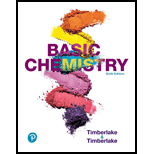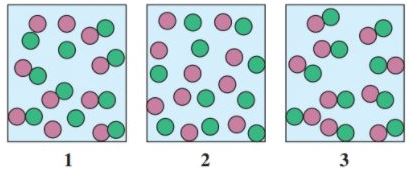
Pearson eText Basic Chemistry -- Instant Access (Pearson+)
6th Edition
ISBN: 9780135765982
Author: Karen Timberlake, William Timberlake
Publisher: PEARSON+
expand_more
expand_more
format_list_bulleted
Concept explainers
Textbook Question
Chapter 12, Problem 89UTC
The chapter sections to review are shown in parentheses at the end of each problem.
12.89 Select the diagram that represents the solution formed by a solute  that is
that is
a. nonelectrolyte
b. weak electrolyte
c. strong electrolyte

Expert Solution & Answer
Want to see the full answer?
Check out a sample textbook solution
Students have asked these similar questions
9. compore the Following two Venctions IN
termy Of Ronction Rate and explan in
detail the reasoning that led to your conclusion
+He p₁₂ 11-
ㅐ 15
.. +He
H #H
H
/
H
b. Compare
the Following too reactions 14
terms of reaction Rate and explain in detail
the reasoning that led to your conclusion
Н
d-C-
tłu
Na
+2446
е
-ll +2n
"H
a.
•Write all of the possible products
For the Following ronction
А
-----
H
-
H
H
+ H₂0 H+
Н
b. in Rite the complete reaction Mechaniszn
For the Formation of each product.
·C. Suggest what Reaction conditions could
Result in each product being the major
Product of the veaction:
a. Write the product For each of the
Following reactions
H
6-836-6
레
+H₂ N
A
H
A-C-C=C-C-CH + 2 Na +2 NH3 -
H H
b. Write the reaction Mechanism For.
reaction
each
Chapter 12 Solutions
Pearson eText Basic Chemistry -- Instant Access (Pearson+)
Ch. 12.1 - Identify the solute and the solvent in each...Ch. 12.1 - Identify the solute and the solvent in each...Ch. 12.1 - Describe the formation of an aqueous KI solution,...Ch. 12.1 - Prob. 4PPCh. 12.1 - Water is a polar solvent and carbon tetrachloride...Ch. 12.1 - Water is a polar solvent and hexane (C6H14) is a...Ch. 12.2 - KF is a strong electrolyte, and HF is a weak...Ch. 12.2 - Prob. 8PPCh. 12.2 - Prob. 9PPCh. 12.2 - Prob. 10PP
Ch. 12.2 - Indicate whether aqueous solutions of each of the...Ch. 12.2 - Prob. 12PPCh. 12.2 - Classify the solute represented in each of the...Ch. 12.2 - Prob. 14PPCh. 12.3 - Prob. 15PPCh. 12.3 - State whether each of the following refers to a...Ch. 12.3 - Prob. 17PPCh. 12.3 - Prob. 18PPCh. 12.3 - A solution containing 80.g of KCl in 200.g of H2O...Ch. 12.3 - A solution containing 80.g of NaNO3 in 75g of H2O...Ch. 12.3 - Prob. 21PPCh. 12.3 - Prob. 22PPCh. 12.3 - Prob. 23PPCh. 12.3 - Prob. 24PPCh. 12.3 - Prob. 25PPCh. 12.3 - Determine whether a solid forms when solutions...Ch. 12.4 - What is the difference between a 5.00(m/m) glucose...Ch. 12.4 - What is the difference between a 10.0 (v/v)...Ch. 12.4 - Calculate the mass percent (m/m) for the solute in...Ch. 12.4 - Calculate the mass percent (m/m) for the solute in...Ch. 12.4 - Calculate the mass/volume percent (m/v) for the...Ch. 12.4 - Calculate the mass/volume percent (m/v) for the...Ch. 12.4 - Prob. 33PPCh. 12.4 - Calculate the grams or milliliters of solute...Ch. 12.4 - Prob. 35PPCh. 12.4 - Prob. 36PPCh. 12.4 - Prob. 37PPCh. 12.4 - For each of the following solutions, calculate...Ch. 12.4 - Prob. 39PPCh. 12.4 - Prob. 40PPCh. 12.4 - Prob. 41PPCh. 12.4 - Prob. 42PPCh. 12.4 - For each of the following solutions, calculate...Ch. 12.4 - For each of the following solutions, calculate...Ch. 12.4 - Calculate the volume, in milliliters, for each of...Ch. 12.4 - Prob. 46PPCh. 12.4 - Prob. 47PPCh. 12.4 - Prob. 48PPCh. 12.4 - A patient needs 100.g of glucose in the next 12h ....Ch. 12.4 - A patient received 2.0g of NaCl in 8h . How many...Ch. 12.5 - Prob. 51PPCh. 12.5 - A can of frozen lemonade calls for the addition of...Ch. 12.5 - Prob. 53PPCh. 12.5 - Prob. 54PPCh. 12.5 - Determine the final volume, in milliliters, of...Ch. 12.5 - Determine the final volume, in milliliters, of...Ch. 12.5 - Prob. 57PPCh. 12.5 - Prob. 58PPCh. 12.5 - Prob. 59PPCh. 12.5 - Prob. 60PPCh. 12.6 - Prob. 61PPCh. 12.6 - Prob. 62PPCh. 12.6 - Answer the following for the reaction:...Ch. 12.6 - Prob. 64PPCh. 12.6 - Prob. 65PPCh. 12.6 - Answer the following for the reaction:...Ch. 12.7 - Prob. 67PPCh. 12.7 - Prob. 68PPCh. 12.7 - Prob. 69PPCh. 12.7 - Prob. 70PPCh. 12.7 - Prob. 71PPCh. 12.7 - Prob. 72PPCh. 12.7 - Prob. 73PPCh. 12.7 - In each pair, identify the solution that will have...Ch. 12.8 - A 10(m/v) starch solution is separated from a...Ch. 12.8 - A 0.1(m/v) albumin solution is separated from a...Ch. 12.8 - Indicate the compartment (A or B) that will...Ch. 12.8 - Prob. 78PPCh. 12.8 - Prob. 79PPCh. 12.8 - Will a red blood cell undergo crenation,...Ch. 12.8 - Prob. 81PPCh. 12.8 - Each of the following mixtures is placed in a...Ch. 12.8 - Prob. 83PPCh. 12.8 - Prob. 84PPCh. 12.8 - Prob. 85PPCh. 12.8 - Prob. 86PPCh. 12 - The chapter sections to review are shown in...Ch. 12 - Prob. 88UTCCh. 12 - The chapter sections to review are shown in...Ch. 12 - Prob. 90UTCCh. 12 - Prob. 91UTCCh. 12 - Prob. 92UTCCh. 12 - Prob. 93UTCCh. 12 - Prob. 94UTCCh. 12 - Prob. 95UTCCh. 12 - Prob. 96UTCCh. 12 - Why does iodine dissolve in hexane, but not in...Ch. 12 - How do temperature and pressure affect the...Ch. 12 - Prob. 99APPCh. 12 - Prob. 100APPCh. 12 - Prob. 101APPCh. 12 - Prob. 102APPCh. 12 - Prob. 103APPCh. 12 - Write the net ionic equation to show the formation...Ch. 12 - Prob. 105APPCh. 12 - Prob. 106APPCh. 12 - Calculate the mass percent (m/m) of a solution...Ch. 12 - Calculate the mass percent (m/m) of a solution...Ch. 12 - How many milliliters of a 12 (v/v) propyl alcohol...Ch. 12 - Prob. 110APPCh. 12 - Prob. 111APPCh. 12 - Prob. 112APPCh. 12 - Prob. 113APPCh. 12 - Prob. 114APPCh. 12 - Prob. 115APPCh. 12 - Prob. 116APPCh. 12 - Prob. 117APPCh. 12 - How many liters of a 4.00MNaCl solution will...Ch. 12 - How many grams of solute are in each of the...Ch. 12 - Prob. 120APPCh. 12 - Prob. 121APPCh. 12 - Prob. 122APPCh. 12 - Prob. 123APPCh. 12 - Prob. 124APPCh. 12 - Prob. 125APPCh. 12 - Prob. 126APPCh. 12 - Prob. 127APPCh. 12 - Prob. 128APPCh. 12 - Prob. 129APPCh. 12 - Prob. 130APPCh. 12 - Prob. 131APPCh. 12 - Prob. 132APPCh. 12 - Prob. 133CPCh. 12 - Prob. 134CPCh. 12 - Prob. 135CPCh. 12 - Prob. 136CPCh. 12 - Prob. 137CPCh. 12 - Prob. 138CPCh. 12 - Prob. 139CPCh. 12 - Prob. 140CPCh. 12 - Prob. 141CPCh. 12 - Prob. 142CPCh. 12 - Prob. 143CPCh. 12 - Prob. 144CPCh. 12 - Prob. 145CPCh. 12 - Prob. 146CPCh. 12 - The following problems are related to the topics...Ch. 12 - Prob. 148CP
Knowledge Booster
Learn more about
Need a deep-dive on the concept behind this application? Look no further. Learn more about this topic, chemistry and related others by exploring similar questions and additional content below.Similar questions
- help draw the moleculearrow_forwardHow to draw this claisen condensation reaction mechanisms/arrow_forwardWrite all of Me Possible Products For each Of the Following reactions. In each case identity all pains of enantiomers, all digsterzoners and all Meso compounds 9. 11-60 11-0-11 V-G Η Η H ~ C-11 +HB+ - 1 H b. पन्ना 171-0-11 H-C-H Н C-C=c-call +HBr Perendez ==arrow_forward
- How can i draw the mechanisms for this molecule?arrow_forwarda. Discuss and explain he difference IN Stability between the Chai and Boat Гольцу от судомехане b. For the Following Molecule draw both possible Clain conformations and explain which one is more stable and for what Reason. H. CH₂ CH₂ H "Harrow_forwarddraw out these molecules pleasearrow_forward
arrow_back_ios
SEE MORE QUESTIONS
arrow_forward_ios
Recommended textbooks for you
 ChemistryChemistryISBN:9781305957404Author:Steven S. Zumdahl, Susan A. Zumdahl, Donald J. DeCostePublisher:Cengage Learning
ChemistryChemistryISBN:9781305957404Author:Steven S. Zumdahl, Susan A. Zumdahl, Donald J. DeCostePublisher:Cengage Learning ChemistryChemistryISBN:9781259911156Author:Raymond Chang Dr., Jason Overby ProfessorPublisher:McGraw-Hill Education
ChemistryChemistryISBN:9781259911156Author:Raymond Chang Dr., Jason Overby ProfessorPublisher:McGraw-Hill Education Principles of Instrumental AnalysisChemistryISBN:9781305577213Author:Douglas A. Skoog, F. James Holler, Stanley R. CrouchPublisher:Cengage Learning
Principles of Instrumental AnalysisChemistryISBN:9781305577213Author:Douglas A. Skoog, F. James Holler, Stanley R. CrouchPublisher:Cengage Learning Organic ChemistryChemistryISBN:9780078021558Author:Janice Gorzynski Smith Dr.Publisher:McGraw-Hill Education
Organic ChemistryChemistryISBN:9780078021558Author:Janice Gorzynski Smith Dr.Publisher:McGraw-Hill Education Chemistry: Principles and ReactionsChemistryISBN:9781305079373Author:William L. Masterton, Cecile N. HurleyPublisher:Cengage Learning
Chemistry: Principles and ReactionsChemistryISBN:9781305079373Author:William L. Masterton, Cecile N. HurleyPublisher:Cengage Learning Elementary Principles of Chemical Processes, Bind...ChemistryISBN:9781118431221Author:Richard M. Felder, Ronald W. Rousseau, Lisa G. BullardPublisher:WILEY
Elementary Principles of Chemical Processes, Bind...ChemistryISBN:9781118431221Author:Richard M. Felder, Ronald W. Rousseau, Lisa G. BullardPublisher:WILEY

Chemistry
Chemistry
ISBN:9781305957404
Author:Steven S. Zumdahl, Susan A. Zumdahl, Donald J. DeCoste
Publisher:Cengage Learning

Chemistry
Chemistry
ISBN:9781259911156
Author:Raymond Chang Dr., Jason Overby Professor
Publisher:McGraw-Hill Education

Principles of Instrumental Analysis
Chemistry
ISBN:9781305577213
Author:Douglas A. Skoog, F. James Holler, Stanley R. Crouch
Publisher:Cengage Learning

Organic Chemistry
Chemistry
ISBN:9780078021558
Author:Janice Gorzynski Smith Dr.
Publisher:McGraw-Hill Education

Chemistry: Principles and Reactions
Chemistry
ISBN:9781305079373
Author:William L. Masterton, Cecile N. Hurley
Publisher:Cengage Learning

Elementary Principles of Chemical Processes, Bind...
Chemistry
ISBN:9781118431221
Author:Richard M. Felder, Ronald W. Rousseau, Lisa G. Bullard
Publisher:WILEY
Solutions: Crash Course Chemistry #27; Author: Crash Course;https://www.youtube.com/watch?v=9h2f1Bjr0p4;License: Standard YouTube License, CC-BY